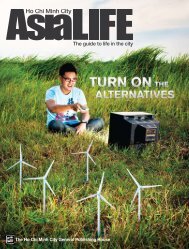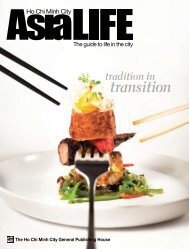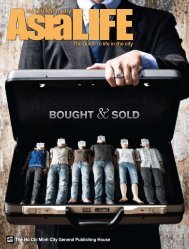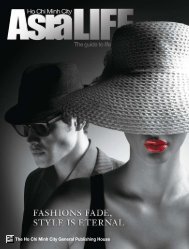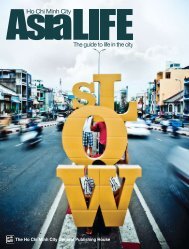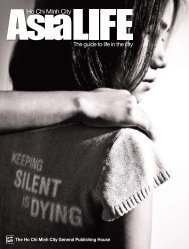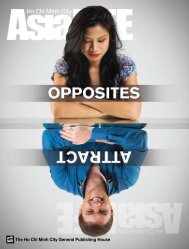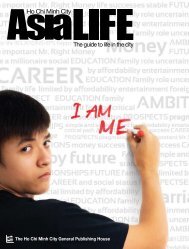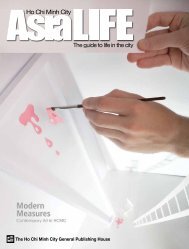asialife HCMC 1 - AsiaLIFE Magazine
asialife HCMC 1 - AsiaLIFE Magazine
asialife HCMC 1 - AsiaLIFE Magazine
You also want an ePaper? Increase the reach of your titles
YUMPU automatically turns print PDFs into web optimized ePapers that Google loves.
sun-worshippers, vendors and,of course, multi-star hotels.Perhaps the most significant ofthese is the Taj Mahal Palaceand Tower, in an area known asColaba. Situated right across theroad from the famous Gatewayof India, built to commemoratea British royal’s arrival in thecountry, the hotel was createdby an industrialist-entrepreneurwho vowed to make it betterthan anything any foreignerhad ever conceived. Today,the Taj, as it is fondly known,is a landmark the world over,and often the location for thatspecial celebrity visit, specialwedding, that special anniversary,any special celebration.The Mumbai resident has a softspot for its beauty, its eleganceand its cachet, and many of usfelt personally violated whenterrorists attacked in November2008, defiling its corridors withbullets and blood. The Oberoiand Trident, too, were similarlyassaulted at the time, even asso many of us watched, horrified,in person, on television, inprint. But recovery was quick,though not easy, and Mumbaishowed off its spirit once again.We are now back to normal,though rather more wary thanbefore, and raring to go, toshow off to the world whatthe city that never sleeps is allabout.For many, Mumbai is synonymouswith Bollywood, theworld where dreams can, andoften do, come true. The Hindifilm industry, with its epicentrein the western suburbs of thecity, is home to famous faceslike Shahrukh Khan, AishwaryaRai, Amitabh Bachchan, AamirKhan and others. Film City,located in the jungle-clad hills,is where stories are created andcaptured for gawking audiencesall over the world. The televisionworld has its own share ofstar power, and has its focus nottoo far away, in Andheri, Maladand Goregaon, beaming a newculture into homes everywhere.Mumbai is as famous for itsstreet food as it is for its stars—in business, in films, on televisionor in style. What AnthonyBourdain called the “Bombayburger” is the ubiquitous vadapau,a heavy, rounded, spicypotato cake stuffed into softbread and munched in alternationwith a tear-inducinglyhot fried green chilli. Almostevery street will have its shareof stalls serving up steamingplates of fragrant and astonishinglygerm-free food, from thesoya-and-chilli sauce drenchedChinese noodles to the softwhite rice cakes, or idlis, eatenwith sharp coconut chutney, tothe crunchy-tangy texturallyrichbhelpuri. There will bezunkha-bhakar, rice pancakeseaten with a hot, polenta-likegramflour paste, and puribhaji,fried wheat pancakes withspicy potatoes, and, of course,sugarcane juice, sweet, cold,refreshing and a real treat on ahot day. Cutting chai, half-fullglasses of thick, sweet, spicedtea will seal the stomach andhelp the digestion. And kulfi,a creamy frozen treat relatedclosely to ice-cream, will demanda return trip. And if youhappen to live and work in thecity, you will very likely use thedabbawalla service, endorsed bycorporate biggies and laudedby Prince Charles, and nowconsidered a model of high-efficiencynetworking and businessmanagement. This is run by anever-increasing group of menwho bustle from home to officeto home again, delivering lunchboxes with foolproof speed andorganization.Perhaps a symbol of Mumbaiis the commuter train system,which the dabbawallas use tobest effect. The electric-poweredcarriages wind their way likeheavy metal worms throughthe heart of the city, takinghordes of professionals fromhome to work and back everyday. A ride on one of theseis fascinating, fast, efficient,exciting, the easiest way to getfrom A to B without taking toolong over it and avoiding thetraffic that makes Mumbai sucha nightmare to travel in. Thereis always something to see outthe windows—and doors—ofthe train; and there is so muchhappening inside too, fromcard games to prayer sessionsto kitty parties to an occasionalbaby birth, a fight, even a deathor two as the unwary dashacross the tracks.And the train is where muchof Mumbai’s go-getting charactercan be seen—there will bea fisherwoman from the Kolicommunity sitting by the door,her ears glinting with heavygold and her bejeweled fingersholding up a brand new, hi-techmobile phone to her ear. Therewill be an aspiring televisionactor learning her lines, pattingher carefully arranged hair intoplace, her clothes and makeupall set to go. There will be an executivebarking orders over thephone while his fingers scuttleover the keyboard of his laptop.And there will always be acouple staring longingly intoeach other’s eyes as they arepressed together in the crush ofthe second-class compartment.This is the city that neversleeps, the city of gold, the citywhere dreams can come true.This is Mumbai. As the songgoes, “Yeh hai Mumbai, meri jaan!”(this is Mumbai, my dear!)48 <strong>asialife</strong> <strong>HCMC</strong> <strong>asialife</strong> <strong>HCMC</strong> 49



